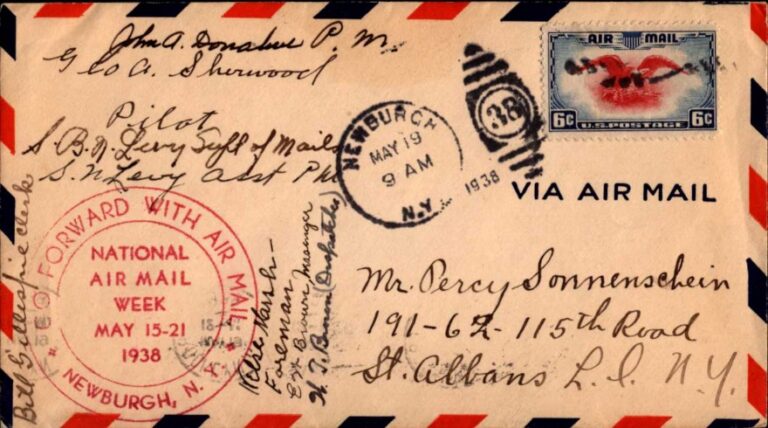What’s in a Name?
The “Wings of West Point” and the Evolution of Stewart International Airport
Martin H. Joyce, III
Stewart International Airport, one of five airports operated by the Port Authority of New York, lies about 10 miles west of the city of Newburgh, New York, and about 65 miles north of New York City. What began in the 1930s as an idea for a local municipal airport, evolved over time into an Army airfield, a U.S. Air Force base, an Air National Guard facility, and finally a commercial airport with regularly scheduled air service. Throughout most of its history, Stewart Airport has played an important role supporting the nearby U.S. Military Academy at West Point. Stewart’s first onsite post office was established in 1942 as a branch of the West Point Post Office, and evolved over time as the airport evolved. Viewed sequentially as a timeline, the postmarks and covers generated by the Stewart Post Office serve to tell its story.
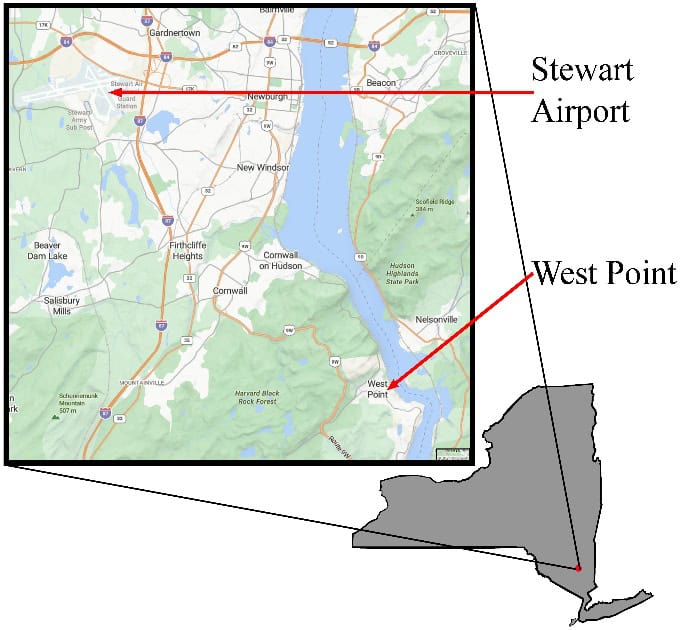
Map 1
(Bing Map, © 2024 Microsoft)
The U.S. Military Academy (USMA), established by Thomas Jefferson in 1802, sits upon the west point of a bend formed by two 90-degree turns in the Hudson River, about 50 miles north of New York City. During the Revolutionary War, General George Washington called the area “the West Point,” and considered it the “key to America,” due to its strategic location. Washington was confident that if the Continental Army established fortifications at West Point, they could stop the British Army from moving upstream (northward) along the river. Washington established his headquarters at West Point briefly in 1779, later moving them to the town of Newburgh, about 15 miles further north along the Hudson.
Newburgh was founded in the early 18th century, and gained prominence once Washington established his headquarters at the farmhouse of the Hasbrouck family, overlooking the Hudson River (now Washington’s Headquarters State Historic Site). Washington proclaimed the Cessation of Hostilities at Hasbrouck House on April 18, 1783. The Post Office Department marked the 150th anniversary of the event with a postage stamp depicting Hasbrouck House (fig.1). First day ceremonies for the stamp were held at the Newburgh Post Office, which had been established in 1804.
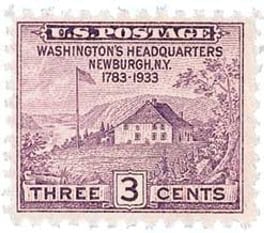
Figure 1
Washington’s Headquarters
Newburgh, NY
One of Newburgh’s early prominent citizens was Lachlan Stewart—who had emigrated from Scotland to the United States as a young boy in the early 1840s. He later skippered packet schooners and sloops out of Newburgh during the period 1850–1870. After he retired from sailing, he ran a lumber business and dairy called Brookside Farm. Stewart and his wife Julia Ann had ten children, some of whom continued to operate the businesses after Lachlan Stewart’s death in 1899.
By 1927, Newburgh’s population was about 30,000. The Newburgh Chamber of Commerce brought to the attention of city officials that “it was necessary for a progressive city to have a municipal airport.” Thomas “Archie” Stewart, a nephew of Lachlan Stewart’s eldest living son Samuel L. Stewart, and a firm believer in the future impact of aviation, suggested to his uncle that unused areas of the family farm could be used for an airfield. Archie later wrote, “Uncle Sam was easy. Always interested in anything beneficial to the community he told me to go ahead with my idea and that he would sign whatever necessary for transferring the property to the City of Newburgh.” Consequently, in 1930, Samuel Stewart donated a 170-acre tract of land from Brookside Farm to the City for the purpose of building such a facility, with the provision that the land would revert to the Stewart family if his wishes were not upheld.
While Newburgh was considering the need for an airport, West Point and War Department authorities had begun to recognize the need for an airfield to support the Military Academy. In July 1926, a hangar and ramp for one amphibious airplane was authorized by the War Department. The project was completed in November 1927, and an Army Air Corps activities section was established. West Point’s first aircraft was an OA-1A Loening Amphibian.
Although construction of Newburgh’s airport began soon after Samuel Stewart’s land donation, the country was experiencing the Great Depression, and funds dwindled over the ensuing years. By 1932, West Point’s Air Corps had three planes, and was considering the need for better facilities. Newburgh offered to share its option on the land with the War Department, who rejected the offer at the time.
At about the same time, Army Chief of Staff Gen. Douglas MacArthur (USMA 1903) directed that a site near West Point be found to teach cadets to fly. Eventually, Newburgh City Council decided to deed the property to the United States, and thus, the War Department tentatively accepted title to the property on September 9, 1936. Construction continued with federal funding. On November 3, 1937, Capt. John M. Weikert (USMA Class of 1923)—who had joined West Point’s Air Corps detachment in 1929, and became its commander in 1932—made the first official landing at Stewart Field.
President Franklin Roosevelt’s and Postmaster General James Farley’s nationwide public relations campaign to promote air mail service launched National Air Mail Week during the week of May 15–21, 1938. Post offices across the country participated with special cacheted covers and postmarks. Newburgh’s airport joined in the celebration on May 19, when nearby Cornwall, NY pilot George Sherwood piloted an Aeronca plane from Newburgh to Floyd Bennett Field in Brooklyn—New York City’s first municipal airport. Ceremonies were held at the start, with special covers available for philatelists and souvenir collectors (see fig. 2).
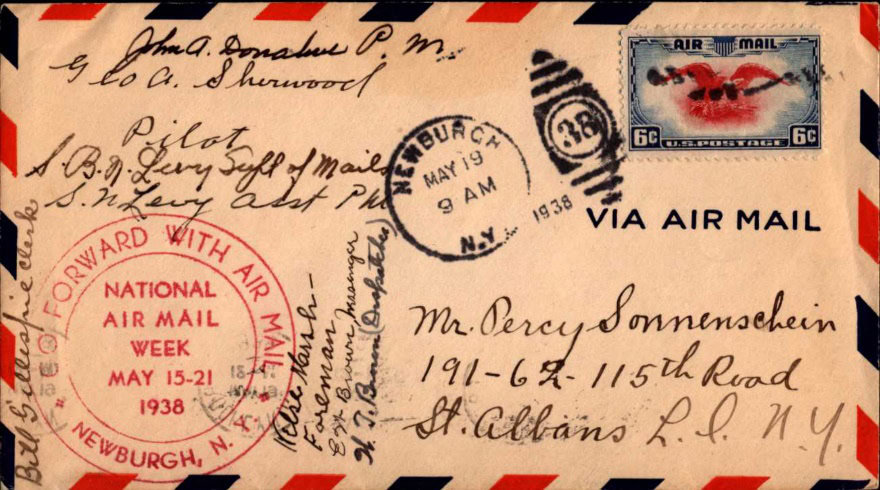
Figure 2
May 19, 1938 Airmail week cover postmarked at Newburgh, and flown by George Sherwood to Floyd Bennet Field in Brooklyn. Signed by Sherwood and Postmaster John Donahue and others.
(Courtesy of Don Lussky)
In October 1939, the City Council passed ordinances to name the field in honor of Lachlan Stewart, and to transfer the entire tract of land to the federal government “in fee simple and absolute.”
Stewart Field became part of the U.S. Military Academy officially in October 1941, when Newburgh deeded it to the U.S. Government for one dollar. Weikert, now a lieutenant colonel, was appointed Commandant. Postal cover collectors from West Point and Orange County (in which the airfield was situated) had marked earlier events—such as Jimmy Doolittle’s Washington Bicentennial flight (1932), and National Air Mail Week—with special covers. A month prior to the deed transfer, a cover dated September 3, 1941 (fig. 3) illustrates that collectors were already looking for similar opportunities at Stewart Field.

Figure 3
September 3, 1941 cover postmarked at West Point, with an air mail cachet, and hand noted “Stewart Field”
Ten months later. on August 25, 1942, Stewart Field was officially dedicated as the “Wings of West Point.” Newburgh Mayor Herbert Warden presented a copy of the original deed to West Point Superintendent Maj. Gen. Francis Wilby (fig. 4). Two hundred forty-five West Point cadets began their flight instruction at the partially constructed facility. By this time, the U.S. had been at war with Japan and Germany for nearly ten months. According to Newburgh’s Evening Times, Colonel Weikert stated that the cadets would be trained at Stewart Field “to meet and prevail over the best that the ruthless Axis partners can send against them, …their wings will carry the hope of the United Nations.”

Figure 5
West Point Superintendent Maj. Gen. Francis Wilby (left) presents a plaque commemorating the dedication of Stewart Field as “The Wings of West Point,” to Col. John Weikert, Commanding Officer. (August 25, 1942)
(USMA Archives)
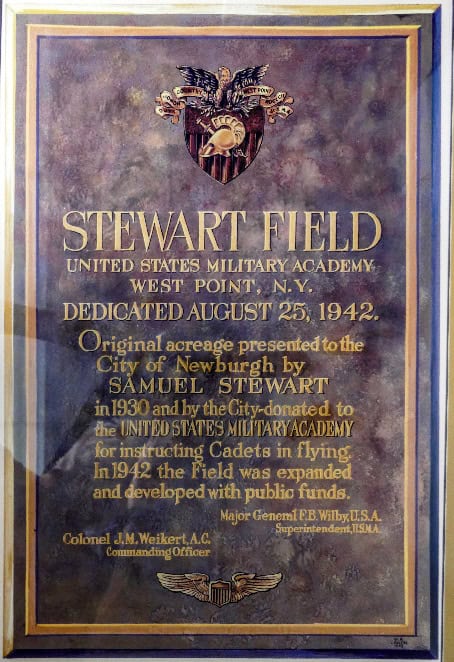
Figure 6
The plaque shown in fig. 5 remains on display at Stewart Airport today.
(Courtesy of Douglas Litts)
Figure 4
Presenting the Deed to Stewart Field (Prop Wash, September 1, 1942) As part of the dedication ceremonies, West Point’s post office canceled 200 covers, along with a special 5-line rubber-stamped cachet (fig. 7).
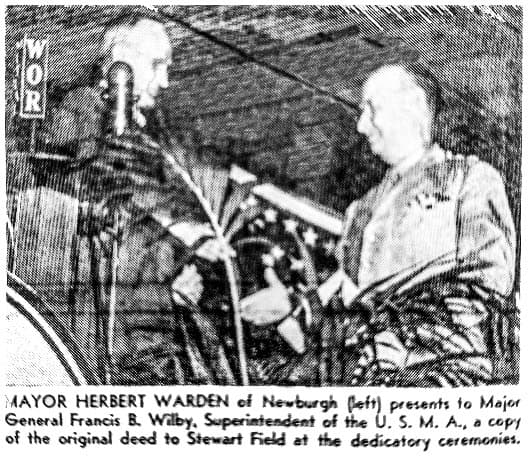
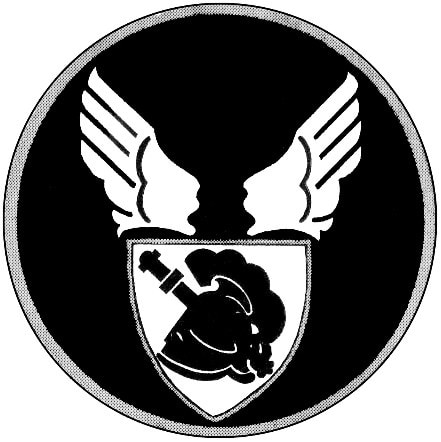
Figure 9
The original “unofficial” Wings of West Point crest, designed by S/Sgt Al Rhodes
( Prop Wash, October 3, 1943)
Figure 8
West Point cadets looking skyward at the dedication of Stewart Field (August 25, 1942).
The small signs above the hangar are inscribed:
“To Tokyo, 8,117 miles” and “To Berlin, 3,121 miles.”
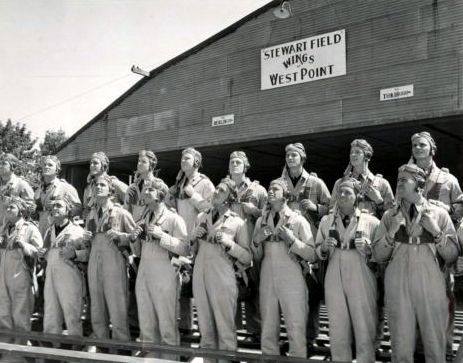
(USMA Archives)
Figure 7
Stewart Airfield Dedication Cover (August 25, 1942)

Together, the two postage stamps on the cover paid the 6-cent Air Mail rate. The stamp on the right is the 4-cent Army stamp (Scott No. 788) from the 1936-37 Army-Navy series. The stamp features Generals Robert E. Lee (USMA 1829) and Stonewall Jackson (USMA 1846).
One of 200 covers hand stamped with a cachet reading:
HEADQUARTERS
AIR FORCE BASIC ADVANCED FLYING SCHOOL
UNITED STATES MILITARY ACADEMY
OFFICE OF THE COMMANDANT
STEWART FIELD, WEST POINT, N.Y.
Less than three months later, the Postal Bulletin dated November 9, 1942 announced that effective November 16, a contract post office would be established at Stewart Field. Subsequently, Stewart Field’s Daily Information Bulletin announced: “The Stewart Field Post Office was officially opened this morning, November 16, 1942. It is located in building #54, directly across from the Post Exchange.” (Bldg #54 was later renumbered to Bldg #1006.) The next day, Stewart Field’s newspaper, Prop Wash, explained that the new post office was a sub-station of the West Point Post Office, and housed in a small brick building along Breunig Rd. (fig. 10). Army Lt. James D. Henley, Stewart Field’s Postal Officer, announced that mail would be taken to West Point on a regular basis (figs. 11, 12).
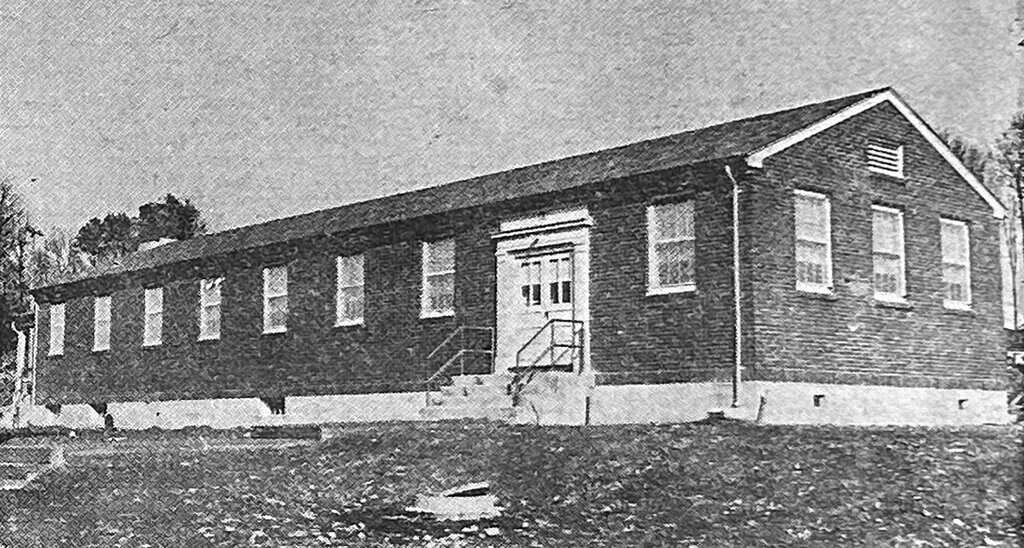
Figure 10
Stewart Field Post Office Building #54 when it opened in November 1942
(Prop Wash, November 17, 1942)

Figure 11 Stewart Field Post Office Opening Announcement
(Prop Wash, Nov. 17, 1942)
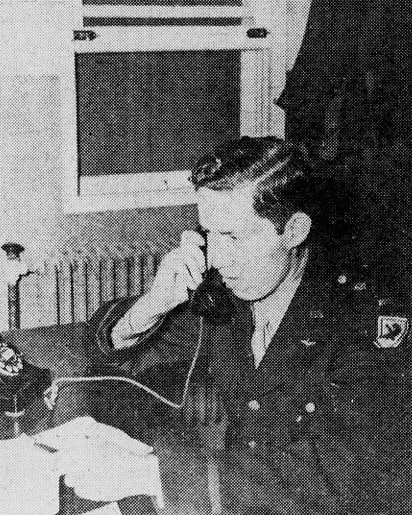
Figure 12
Lt. James D. Henley, Stewart Field Postal Officer
As one of the Field’s junior officers, Henley filled a variety of roles, including Theater Officer and Assistant PX Officer. (Note the West Point shoulder patch and Army Air Corps lapel insignia.)
(Prop Wash, Dec. 15, 1942)
The first contract “postmaster” was Sally M. Poore, a lifelong resident of Highland Falls, located just outside West Point’s main gate. As a contract employee, Poore was not officially a “postmaster,” though post office patrons probably referred to her as such.
This 1-cent paid reply postal card (Scott No. UY6) was signed by contract postmaster Sally M. Poore. It was postmarked on February 16 at Stewart Field, and again the next day at the West Point Post Office.
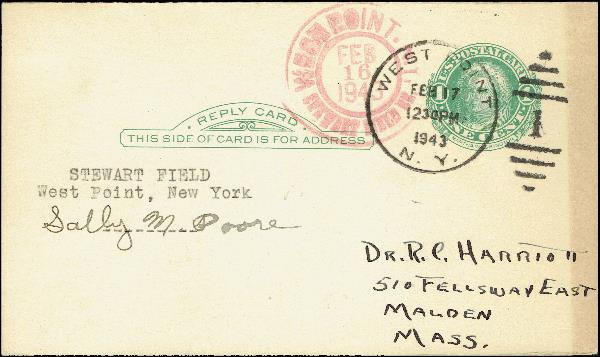
Figure 13
“Stewart Field Br. West Point N.Y.” Postmark (February 16, 1943)
Map 2
Location of Original Stewart Field Post Office
Although the Post Exchange and Administration Building are still in use today,
the post office building was demolished in 1989.

(Map: Stewart Air Force Base, Unofficial Directory and Guide, 1969-70)
In April 1942, the Postal Bulletin announced that active duty military service members were granted free franking privileges for outgoing First-Class Mail. World War II era free franking privileges continued through 1947. The cover seen in fig. 14, sent by Corporal Paul Blank of the 657th School Squadron at Stewart Field is an example. Postmarked at New York City’s Grand Central Station, the stationery likely came from either the Newburgh USO (which had opened in the Newburgh YMCA in late1942) or the USO lounge at Grand Central Station.
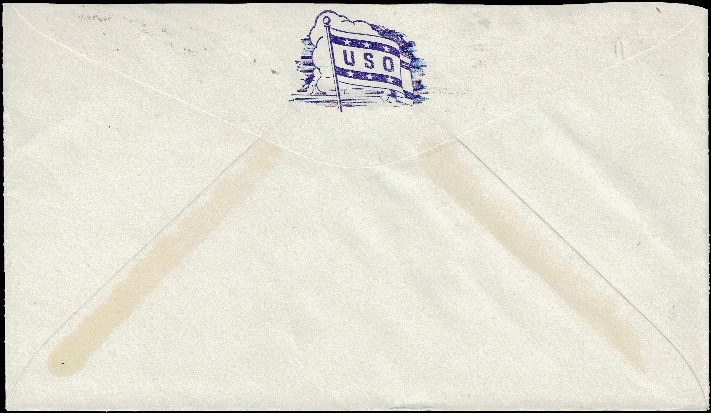
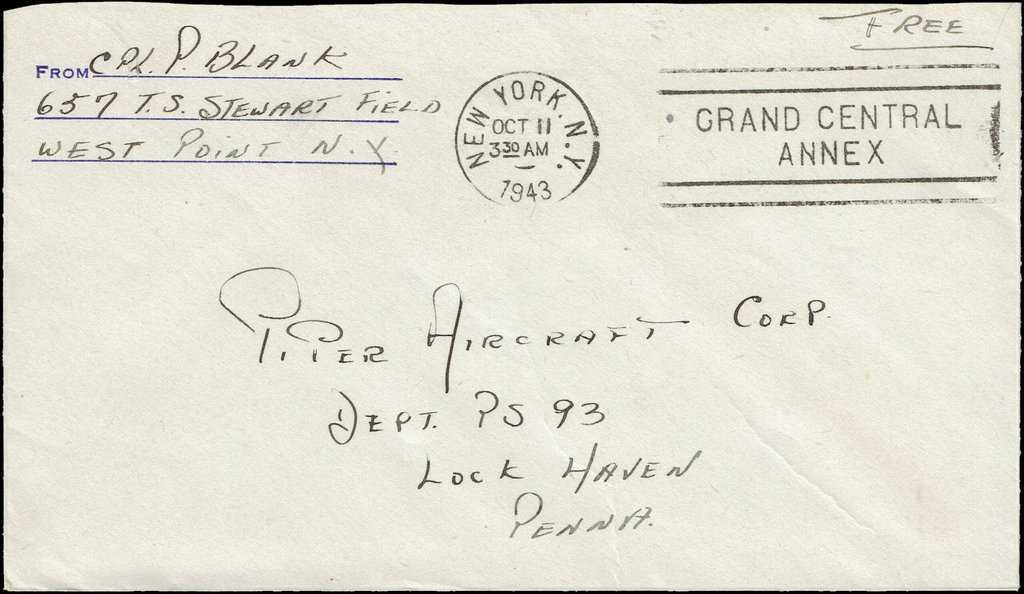
Figure 14
Free Frank cover (October 11, 1943)
The Stewart Field branch operated as part of the West Point Post Office for less than one year. Responsibility for the branch transferred to the Newburgh Post Office on November 1, 1943. Stewart Field’s Daily Information Bulletin announced:
Effective today the Post Office address of Stewart Field will be Stewart Field, Newburgh, New York, instead of West Point, New York, and all correspondence not having this correction will be returned to the writer. Careful attention should be given that all letterheads should be typed over to designate the Post Office address as Newburgh, New York.
Stewart Field expanded rapidly as the requirements for Army aviators grew to support the Allied war effort. When cadet aviation training began in 1942, military aviation was still a dangerous activity—and even more so when compromises were made to accommodate a cadet’s full academic load. A number of cadets were killed or injured during this training. The cover of the April 1944 cadet magazine The Pointer appears to make light of these risks (fig. 15).
Figure 15
Cartoon depicting a cadet aviation student and flight instructor about to crash into a Newburgh water tower.
This appeared on the cover of the West Point cadet magazine The Pointer (April 14, 1944).
(Illustration by Cadet Charles W. Cross, photo courtesy of Scotty Austin)
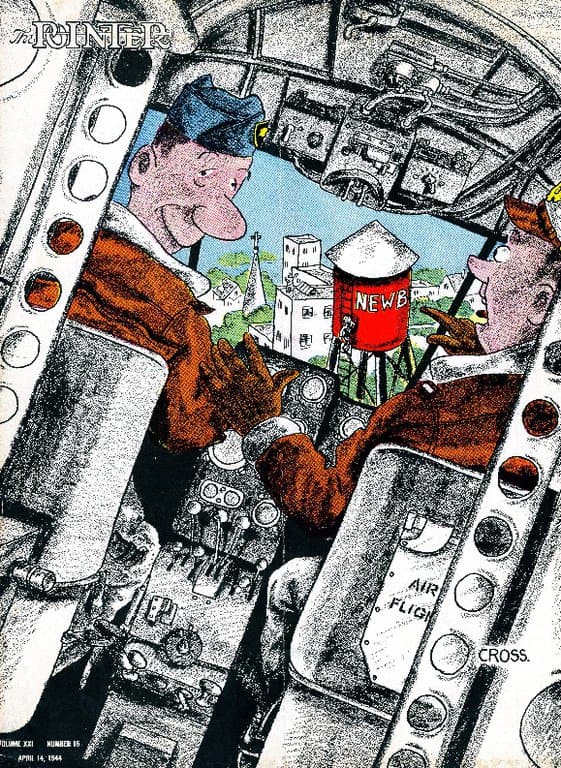
Stewart’s role in training pilots was not limited to West Point cadets. In late 1943, the Army decided that Stewart’s facilities would include groups of other aviation cadets in its advanced courses. On February 8, 1944, the first group of 75 aviation cadets (other than West Point students) completed their training and were awarded their flight wings, simultaneously being commissioned as second lieutenants in the Army Air Corps. Subsequent groups graduated and were commissioned every several months.
 (PropWash, November 2, 1943
(PropWash, November 2, 1943
Figure 16
Military Mail Clerk
Although Stewart Field was an Army Air Corps facility, its external mail services were provided by the civilian Post Office Department. Within the military units assigned to Stewart Field, responsibility for internal mail distribution was assigned to military mail clerks, and often performed by members of the Women’s Army Corps. It was not unusual for the base newspaper Prop Wash to feature photos of women performing various roles at Stewart Field, usually accompanied by captions that would be considered inappropriate by today’s standards (see fig. 16).
Aviation training for West Point cadets at Stewart Field ended in 1946. More than 1,000 Military Academy cadets had been commissioned directly into the Army Air Corps following graduation from West Point between 1943 and 1946.
Following the establishment of the U.S. Air Force in 1947, Stewart Field was transferred to the Air Force, and renamed Stewart Air Force Base. Although the Newburgh Post Office continued to provide mail service for the Base, mail items processed on the Base post office were postmarked “Stewart Air Force Base” (see figs. 17a, 17b, 18). In February 1951, the post office was reorganized as a classified unit (and thus staffed with postal employees) and no longer operated as a contract post office.

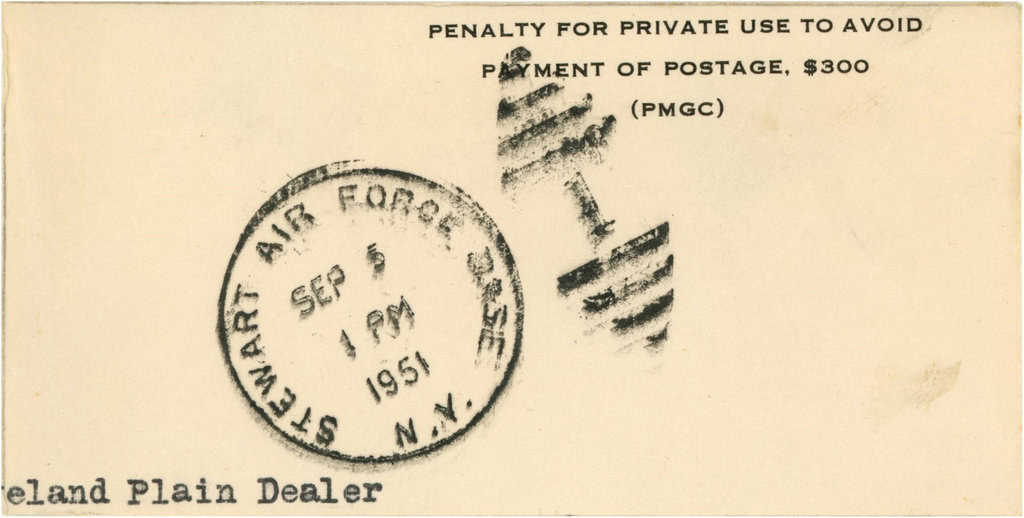
Figures 17a, b
Examples of handstamped
Stewart Air Force Base Postmarks (1951)
(Courtesy of National Postmark Museum)

Figures 18
Stewart Air Force Base
Machine Cancel (1953)
In 1967, The Orange County (NY) Stamp Collectors Club celebrated the 25th anniversary of Stewart Air Force Base during its third annual Orange County Philatelic Exhibition (ORPEX). Commemorative cachets featured Lachlan Stewart, whose family donated the land for the original airfield, along with an AT-6 trainer aircraft used in 1942, and a modern Delta jet for the period (fig. 19).
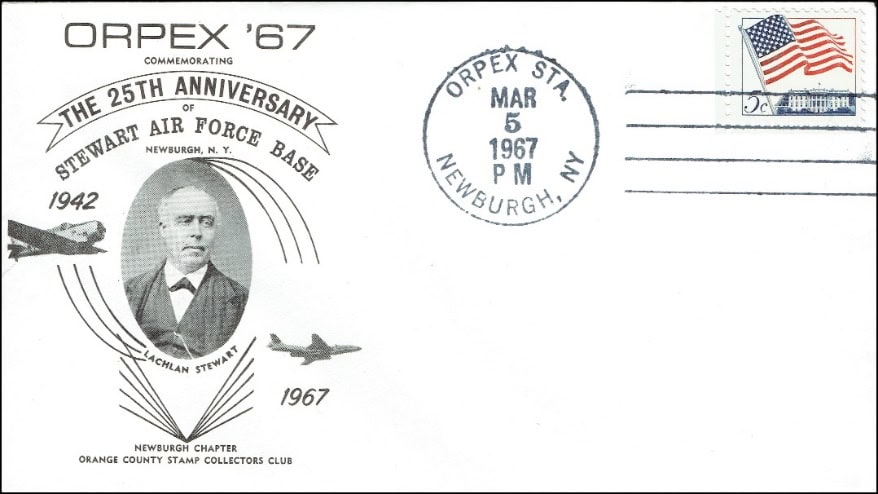
Figure 19
ORPEX ’67 Commemorative Cover marking the 25th Anniversary of Stewart Field
In October 1969, U.S. Defense Secretary Melvin Laird announced that more than 300 military installations around the world would be closed or reduced to control defense spending. Stewart Air Force Base was among the facilities to be deactivated. In November, a further announcement was made that the U.S. Army would retain a few facilities at Stewart to support West Point. These included a small Army air detachment (the “Wings of West Point”) and base housing facilities to supplement existing housing on Military Academy grounds.
By that time, Stewart Air Base had expanded to 1,550 acres. It was sold to the Metropolitan Transit Authority (MTA) of New York with the intention of returning to its originally conceived concept as a regional commercial civilian airport. On March 1, 1970, the facility was re-dedicated as Stewart Airport. (see fig. 20). Interestingly, the airport post office continued to use Stewart Air Force Base nomenclature in its postmarks (see figs. 21a, b).
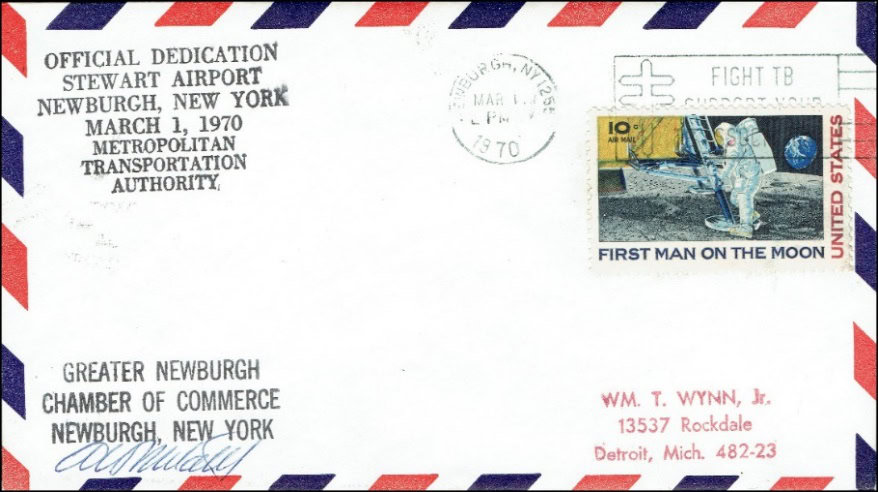
Figure 20
Airport Dedication cover marking the official opening of Stewart Airport
as a commercial civilian airport. (Postmarked Newburgh, NY, March 1, 1970)
Figures 21a, b
Handstamped Stewart Airport Postmarks continuing to use “Stewart Air Force Base” nomenclature
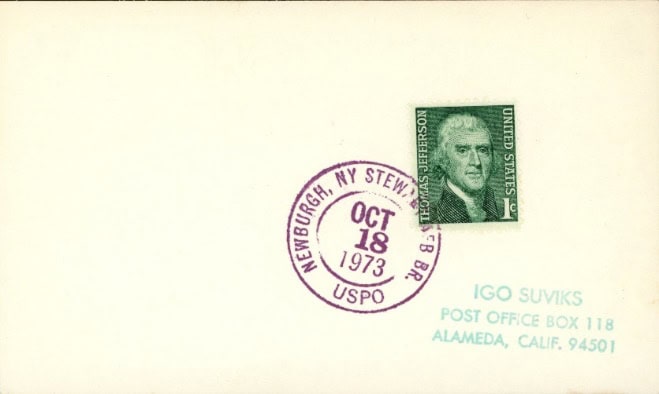
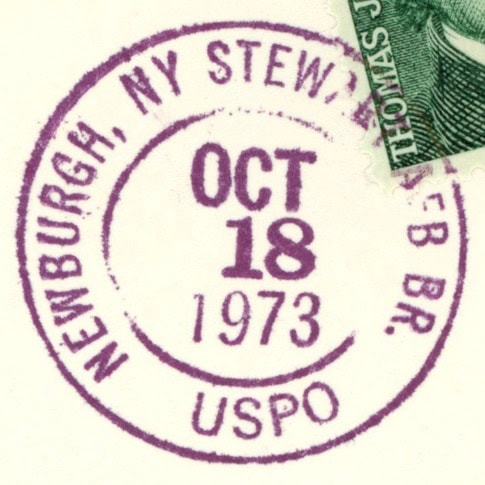
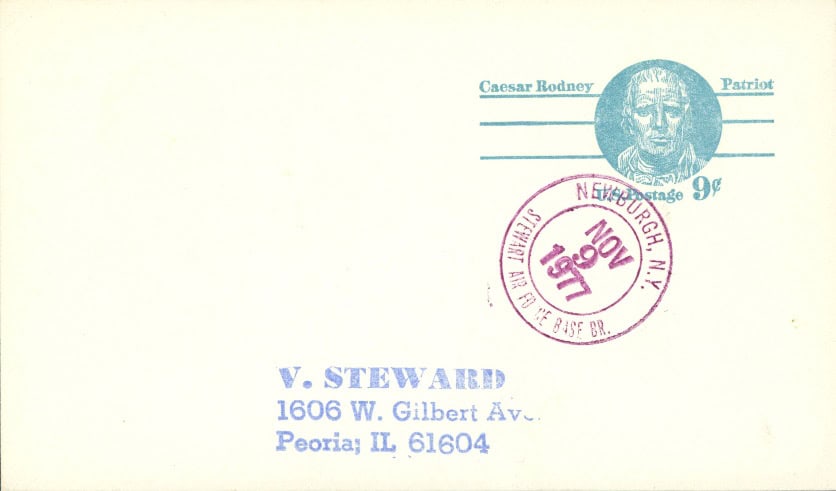
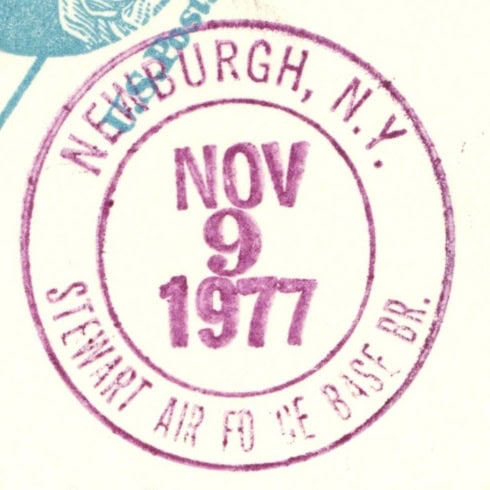
(Courtesy of National Postmark Museum)
Although the military continued to operate flights to and from Stewart on a limited basis, it would take nearly two decades for the MTA to develop Stewart into a viable commercial airport. The author recalls flying out of Stewart on a C-130 aircraft as part of cadet summer training in June 1973. In 1980, part of the facility was used to establish the Stewart Air National Guard Base (ANGB) by agreement between the New York State and the NY Air National Guard (NYANG). The next year, Stewart earned national recognition as the arrival airport for the American hostages freed from Iran.
By the 1980s, and continuing thereafter, postmarks included variations of “Stewart Airport Br, Newburgh, NY” (figs. 22a–c).
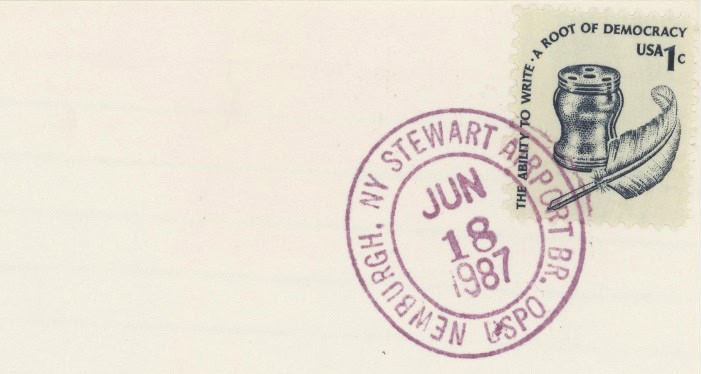
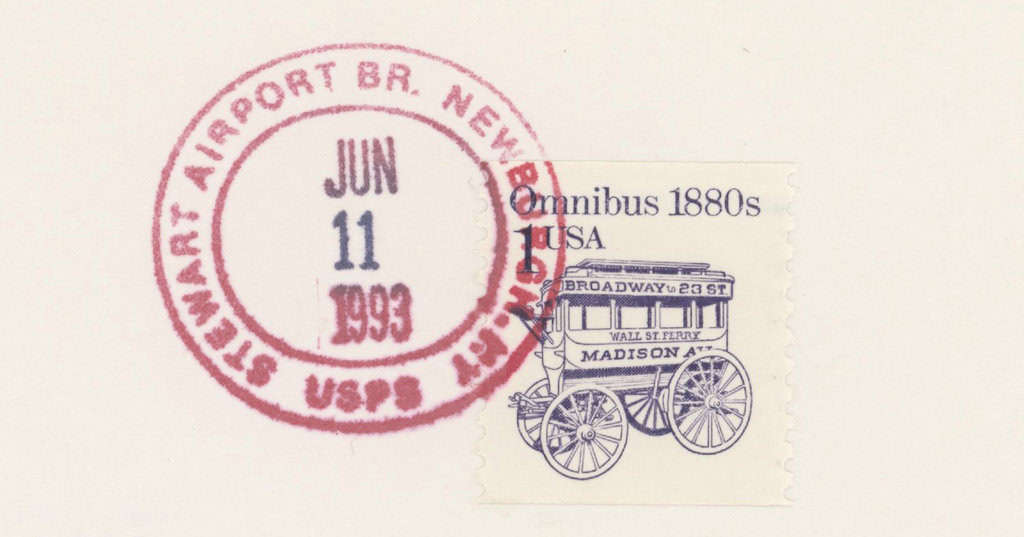
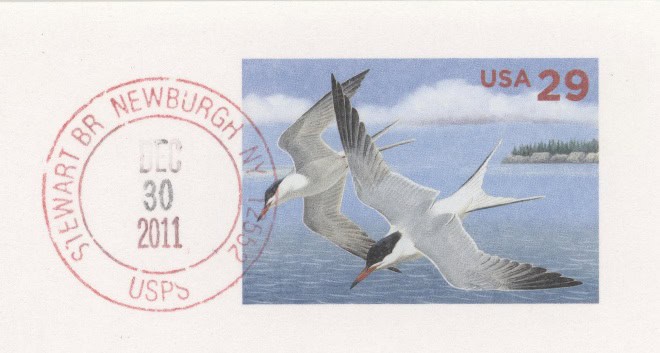
Figures 22a-c
Handstamped Stewart Airport Postmarks 1987–2011 showing variations of “Stewart Airport Br.”
(Courtesy of Kelvin Kindahl)
In May 1989, officials announced a major airport expansion, including a passenger terminal. In order to provide sufficient parking space for the anticipated increase in traffic, the area in front of the existing terminal was to be leveled—including the Breunig Rd. post office. Postal operations were to be moved to a larger general mail facility being constructed in an industrial park on airport grounds. The original post office was razed later that year.
In early 1990, Stewart Airport announced that its first regularly scheduled passenger air service would begin that April. American Airlines planned to run several flights daily to and from its hubs in Chicago and Raleigh/Durham. At the same time, the U.S. Postal Service announced that mail would be carried on these flights as well, and that first flight covers would be offered (fig. 23).
Today, consumer retail services are provided in the front section of the mail facility constructed in 1990, and continue to operate as a branch of the Newburgh Post Office (see fig 24). The larger facility is referred to as the Mid-Hudson NY Processing and Distribution Center (P&DC). In 2012, USPS announced that mail processing operations would move from the Newburgh facility to the Albany, NY P&DC. After several delays, this move was completed in 2021. In 2022, USPS announced that the Mid-Hudson P&DC would be transformed into one of the first of ten new Sorting and Delivery Centers (S&DC).
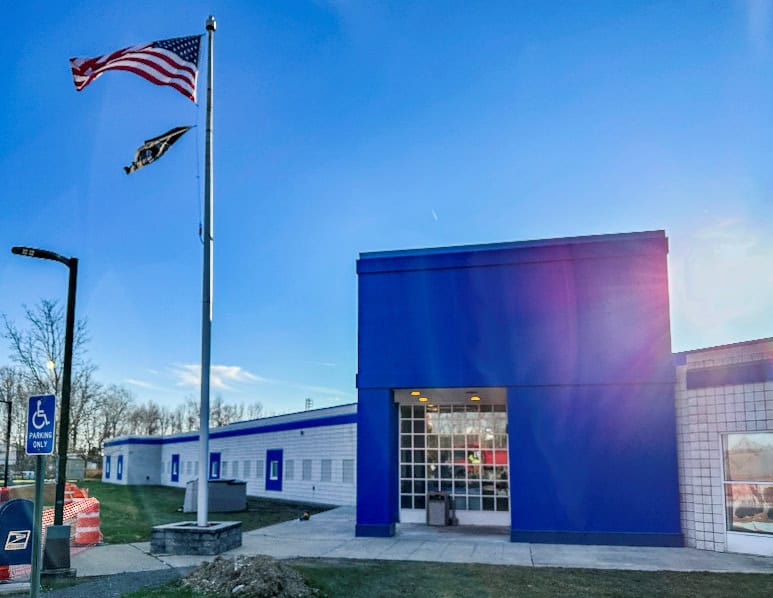
Figure 24
USPS Mid-Hudson NY Processing and Distribution Center, Stewart Airport
(November 30, 2023)
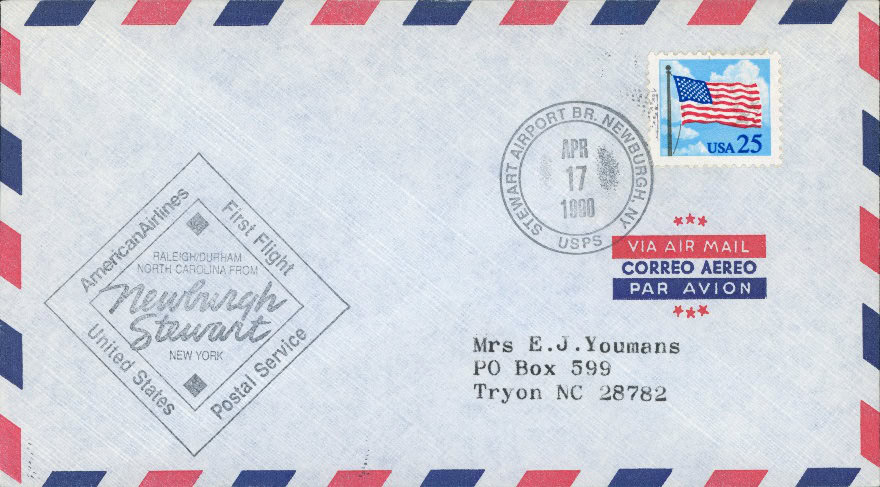
Figure 23
First Flight cover marking regularly scheduled air service to and from Stewart Airport (April 17, 1990)
(Courtesy of National Postmark Museum)
When the Zone Improvement Plan (ZIP) system was established in 1963, ZIP code 12550 was established for Newburgh (including Stewart Air Base). In December 1965, several ZIP codes were added to that geographic area, and ZIP code 12554 was assigned to Stewart Air Force Base (though the author has not seen any postmarks with that ZIP code). When the new Mid-Hudson S&DC was announced in 2022, its ZIP code was listed as 12550-8344; today, the USPS website for the Stewart S&DC shows 12555-9996. When the author visited the retail operation at the facility in November 2023 and requested a handstamped cover on a handback basis, the postmark included ZIP code 12552-9998 (fig. 25). Another cover dropped in the facility’s outgoing mailslot was machine cancelled in Albany, NY—presumably at the Albany P&DC noted earlier (fig. 26).
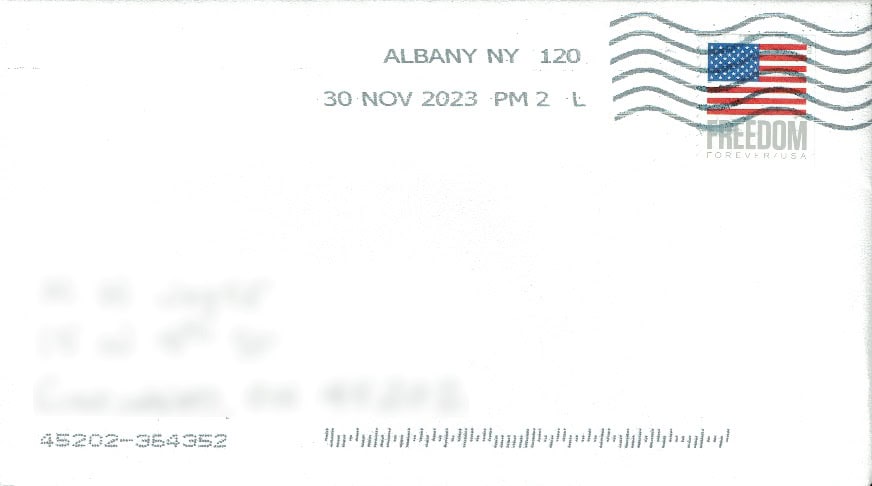
Figure 26
Cover mailed at Stewart Airport Post Office, processed at Albany P&DC (November 30, 2023
Figure 25
Handstamped Stewart Airport Postmark (November 30, 2023)
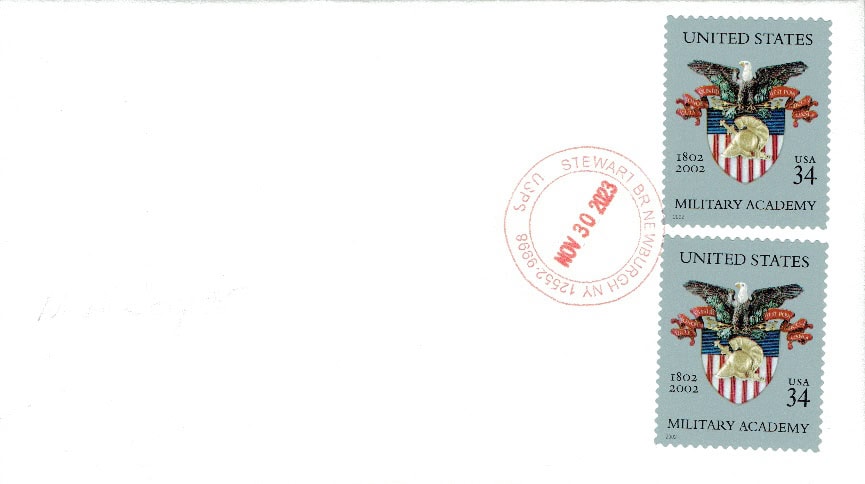
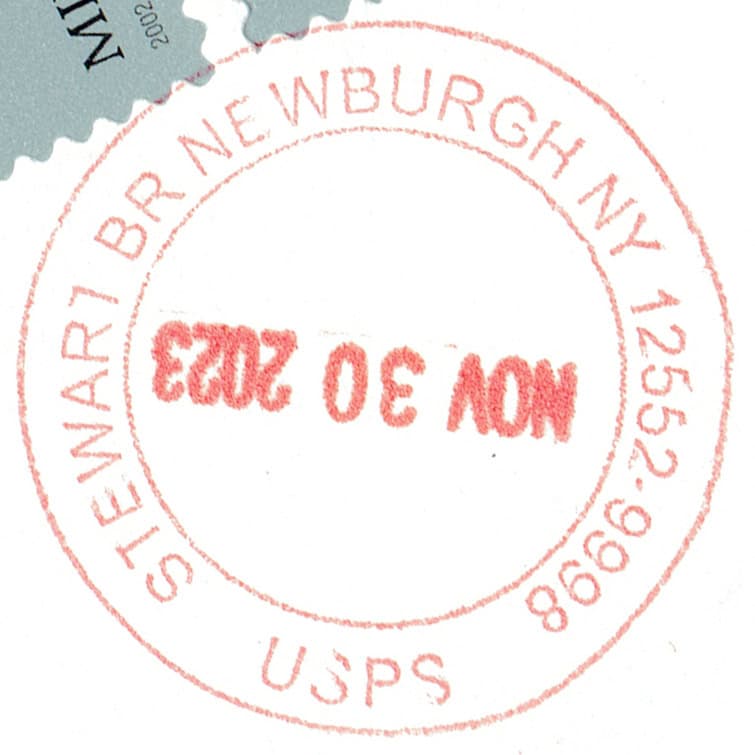
Stewart Airport was privatized in 2000 when the NYS Department of Transportation awarded a 99-year lease on the airport to UK-based National Express. Seven years later, the Port Authority of New York bought the remainder of the lease. It was rebranded as New York Stewart International Airport in 2018.
Today, Stewart International Airport (SWF)—the small, regional airfield envisioned by Newburgh leaders in the midst of the Great Depression—offers many travelers living in southeastern New York State a smaller and more convenient option for air travel compared with JFK, LaGuardia, and Newark airports. According to a recent Airport Master Record, the airport had 34,578 aircraft operations for the 12-month period ending in January 2024, averaging 65% general aviation, 15% military, 10% air taxi, and 10% commercial (primarily Frontier and Allegiant). PLAY airlines (Iceland) operates international flights to and from Iceland and several European airports.
Stewart’s military mission continues. The Air National Guard Base occupies about 260 acres, and is the base of the 105th Airlift Wing, an Air Mobility Command unit of the NYANG, and “host” wing for the installation.
Stewart Army Subpost and the Stewart-Newburgh Armed Forces Reserve Center are also located on Stewart ANGB. Stewart Army Subpost supports the 1st Battalion, 1st Infantry Regiment, and the UH-72 Lakota-equipped 2nd Aviation Detachment (the current “Wings of West Point”), both of which support the Military Academy. The aviation detachment transports distinguished visitors hosted by West Point senior leadership, provides support to the cadet parachute team, and assists cadets in academic instruction in both airplanes and helicopters.
For over 80 years, through various owners, resident tenant operators, and changes in mission, Stewart’s postmarks and covers prepared by creative and observant collectors have helped to tell its story. Stewart’s postal legacy will endure as an important perspective on its history.
Author’s Note: The author wishes to express his thanks to Don Lusky (American Air Mail Society), as well as Kelvin Kindahl and Dave Gill of the Post Mark Collectors Club and National Postmark Museum for their assistance in providing materials for this article.
About the Author
Martin H. (Jay) Joyce is a 1974 graduate of the United States Military Academy at West Point, New York. He served six years on active duty in the U.S. Army, followed by a 35-year career in the consumer products industry. He is the author of Postmarked West Point: A U.S. Postal History of West Point and its Graduates (2021), and The West Point Post Office, 1815–1981 (2023), as well as numerous articles on the philatelic and postal history of West Point and the U.S. Naval Academy.
References
Dillon, John J., and Charles Frier, History of Stewart Field, 1943-1944. U.S. Military Academy, West Point, 1944.
McTamaney, Mary, “From farmland to International Jetport.” HudsonValleyTimes.com, March 28, 2019.
Office of Information Services USAF, “History of Stewart Air Force Base.” In Orange County Guide, edited by Milo M. Oblinger, 69‑72. Passaic (NJ): I. Solomon Printers, 1956.
Pappas, George S, “Wings of West Point.” Assembly, November 1992.
PropWash (Stewart Field newspaper), various issues. Courtesy of USMA Archives.
Stewart Air Force Base, Unofficial Directory and Guide, 1969-70. San Diego: Military Publishers, Inc., 1970.
